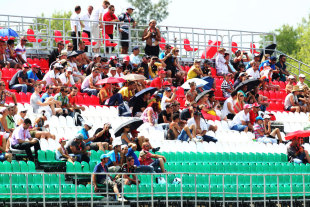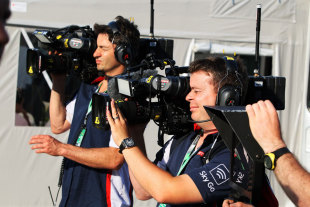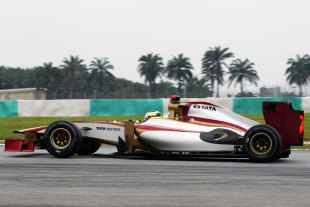
It's a sad fact that, despite a season of nail-biting action on track, attendance at grands prix is noticeably down this year.
Organisers of the European Grand Prix at Valencia elected to remove grandstands to account for the reduced demand for tickets, and were still faced with swathes of unsold seats. In Monaco, that jewel in Formula One's crown, the blue of unoccupied grandstand space was uncomfortably bright in the sun. Even Montreal failed to attract a sell-out crowd.
And while it's easy to point the finger at high ticket costs and the on-going financial crisis, both of which combine to make Formula One a painfully expensive sport to follow live, the impact of television should not be dismissed.
Attending a race as a fan is an exhilarating experience. There's the roar of the engines, the thrill of the crowds, and the physical intensity of feeling the cars rush by. But it's also a long day spent in either the sun or the rain, faced with expensive food and drink, endless lines for the loos, and an awful lot of thumb-twiddling between sessions.
Some circuits cater well for fans, and put on all manner of auxiliary entertainment, from circus skills tents for kids to bungee rockets and BMX performances. But many let the action on track do all the talking, and when there's no action on track then there's nothing to do.
It's easy to blame the circuits for the high cost of tickets, but they suffer from the perennial problem of struggling to afford the in-built escalators that turn F1 hosting contracts from expensive to impossible. With no money coming their way from trackside advertising revenues (all of which go to Formula One Administration at the majority of tracks on the calendar), circuits without state funding have no choice but to inflate their entry costs to cover the hosting fees.
For a family of four to attend the 2013 British Grand Prix at Silverstone would cost £496 (three-day general admission). That same family of four could have a week in Majorca for £503. Given that a ticket to the grand prix doesn't take into account the cost of travel, accommodation, or any food, it is increasingly difficult for families to argue for a weekend's rain-soaked racing over a week-long break in the sun.
And when the TV package they're being offered - for roughly the same annual cost as those four three-day tickets - is more comprehensive than anything they can get at the circuit? It makes far more sense to stay home.

When they took over the UK rights from ITV in 2009, the BBC were able to use their Red Button to give fans greater access to F1 than they'd had before (notwithstanding Bernie Ecclestone's failed F1 Digital attempt). In addition to their in-depth and award-winning pre- and post-race shows, the BBC gave fans a post-race forum, the opportunity to watch reruns of classic races, and offered a driver tracker on their website. When coupled with the then-free live timing app available from FOM, fans at home were able to watch the race with almost as much data as journalists reporting from the circuit media centre.
Sky have taken that approach to the next level, and now offer their viewers a service called Race Control that gives them access to more data and camera options than is available in the press room. With a choice of on-board cameras and battles to follow, fans sitting at home can now watch the race that suits them, be it the fight at the front or drama in the middle of the pack.
But despite the expansive nature of their offering, Sky simply aren't doing the numbers. If fans are staying away from the circuits because they have more information and better access in their living rooms, they're not watching the races lives on Sky. While it's only to be expected that a subscription-only service would fail to attract the numbers of their free-to-air counterparts, viewer numbers on SkySportsF1 are significantly lower than the millions who watched Formula One on the BBC.
The channel does not publish viewer statistics, but external TV auditors provide figures that indicate that there has been no significant audience growth over the course of the season. Instead, Sky's viewing figures rise and fall depending on whether or not it has sole live broadcasting rights of the race in question.
Britain is but a small segment of Formula One's global viewing figures, but given that the combined free-to-air and subscription model has been enough of a success that Sky will repeat the trick in Italy next year, splitting coverage with RAI, it is likely that this downwards trend will continue.
Terrestrial broadcasters are struggling to afford the broadcasting fees being charged by Formula One Management, which places a high premium on its product. And where advertising revenues were once able cover the costs of F1 in the majority of markets, the worsening global financial situation since 2008 has seen broadcasters struggle to make ends meet.
In a separate blow to the traditional broadcasters, viewers are now getting a significant chunk of their media from non-traditional sources, and TV revenues are falling as their once-reliable customers seek out entertainment elsewhere, primarily online.
Where a free-to-air broadcaster must have viewers, a subscription service needs only subscribers. As far as Sky is concerned, it matters little how many people are watching Formula One as long as people are buying their package. For as long as people continue to subscribe to the packages that include the F1 offering, Sky do not need to concern themselves with attracting viewers to their programmes. The paying audience is what matters - actual eyeballs are but the icing on the cake.
Unfortunately, where sponsors are concerned, eyeballs are all that matter. Even Ecclestone was once wary of the effect of subscription-only TV on Formula One. Speaking in reference to the then-rumoured BSkyB takeover bid of F1, in May 2011 the F1 supremo acknowledged that high viewing figures were vital to the sport's many sponsors.
"Sky is doing an incredible job but if you look at their audience, they are nowhere," he said. "With these figures it would be almost impossible for teams to find sponsors. That would be suicidal."
In 2011, sponsors paid a reported $887 million into Formula One. Figures for 2012 are not yet available, but are widely expected to be down. While no one is talking on the record, a number of teams are struggling to make ends meet thanks to declining sponsorship income, and there are concerns that some won't make it.
Because at the moment, Formula One is a hard sell. The blue chip brands with the big money to spend are wary of being associated with the negative press surrounding the Gribkowsky scandal and the widely-criticised decision to press ahead with this year's Bahrain Grand Prix, and declining viewing figures don't make the hard sale any easier.

Teams are now changing their approach, going after a greater number of sponsors at a lower cost in an effort to plug the hole. But because part of the attraction of Formula One is in its perceived exclusivity, there is a limit to the number of additional sponsors that can be added - brand bombardment doesn't help anyone.
There's no denying that Formula One is in a period of financial decline caused in part by the global financial crisis. But the biggest problem is the separation between the realities of the current economic climate and the persistent increases in hosting and broadcasting fees.
The in-built escalators in race hosting contracts may have been designed to guard against inflation, but at the moment they are putting the cost of a ticket out of reach of a significant number of fans, making it increasingly difficult for circuits to afford grands prix. Classic tracks are falling off the calendar, or fighting to survive, while even new arrivals like Singapore are protesting the high price they pay.
And because the broadcasting fees charged by FOM have not taken into account global declining advertising revenues and a slow but steady drop in worldwide F1 viewing figures since 2006, free-to-air television is on the wane and fans are being priced out of following their sport on TV. Many have turned to online streams and torrents.
Fans matter. It may not feel like it at times, but every pair of eyeballs watching a TV broadcast of a race is helping the teams on screen pick up sponsors. Without the fans, the sponsors turn away. Without the sponsors, the teams can't afford to race. It sounds simple, because it is.
Television might not be the future of Formula One. If properly managed, the Tata Communications deal could see FOM delivering its feed directly to the home entertainment system, and charging both viewers and sponsors for the privilege. There's certainly profit in it.
The fans are the only thing that can guarantee F1's future, and it's worth remembering that before the vast majority are priced out of the market.

